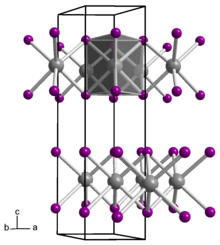Gadolinium diiodide
Appearance
(Redirected from Gadolinium(II) iodide)
 | |
| Identifiers | |
|---|---|
3D model (JSmol)
|
|
PubChem CID
|
|
| |
| |
| Properties | |
| GdI2 | |
| Molar mass | 411.06 g·mol−1 |
| Appearance | bronze solid[1] |
Except where otherwise noted, data are given for materials in their standard state (at 25 °C [77 °F], 100 kPa).
| |
Gadolinium diiodide is an inorganic compound, with the chemical formula of GdI2. It is an electride, with the ionic formula of Gd3+(I−)2e−,[2] and therefore not a true gadolinium(II) compound. It is ferromagnetic at 276 K with a saturation magnetization of 7.3 B; it exhibits a large negative magnetoresistance (~70%) at 7 T near room temperature.[3] It can be obtained by reacting gadolinium and gadolinium(III) iodide at a high temperature:[4]
- Gd + 2 GdI3 → 3 GdI2
It can react with hydrogen at high temperature (800 °C) to obtain gadolinium hydrogen iodide (GdI2H0.97[5]).[6]
References
[edit]- ^ Haynes, William M. (2012). CRC handbook of chemistry and physics : a ready-reference book of chemical and physical data. Boca Raton, Fla.: CRC. p. 84. ISBN 978-1-4398-8049-4. OCLC 793213751.
- ^ Greenwood, Norman N.; Earnshaw, Alan (1997). Chemistry of the Elements (2nd ed.). Butterworth-Heinemann. p. 1240–1242. ISBN 978-0-08-037941-8.
- ^ K Ahn, C Felser, R Seshadri, R.K Kremer, A Simon (May 2000). "Giant negative magnetoresistance in GdI2". Journal of Alloys and Compounds. 303–304: 252–256. doi:10.1016/S0925-8388(00)00668-X. Archived from the original on 2022-01-23. Retrieved 2022-07-08.
{{cite journal}}: CS1 maint: multiple names: authors list (link) - ^ François Nief (2010). "Non-classical divalent lanthanide complexes". Dalton Transactions. 39 (29): 6589–6598. doi:10.1039/c001280g. ISSN 1477-9226. PMID 20631944. Retrieved 2022-07-08.
- ^ Michaelis, C.; Mattausch, H.; Simon, A. LnHal2Hn - new phases in the ternary system lanthanide/halogen/hydrogen. II: preparation. Zeitschrift fuer Anorganische und Allgemeine Chemie, 1992. 610: 23-27. ISSN 0044-2313.
- ^ C. Michaelis, W. Bauhofer, H. Buchkremer-Hermanns, R. K. Kremer, A. Simon, G. J. Miller (December 1992). "LnHal2Hn – Neue Phasen in den ternären Systemen Ln/Hal/H (Ln = Lanthanoid, Hal = Br, I) III. Physikalische Eigenschaften". Zeitschrift für anorganische und allgemeine Chemie (in German). 618 (12): 98–106. doi:10.1002/zaac.19926180118. ISSN 0044-2313. Archived from the original on 2022-07-11. Retrieved 2022-07-08.
{{cite journal}}: CS1 maint: multiple names: authors list (link)
